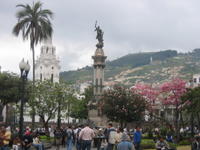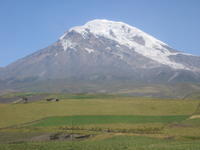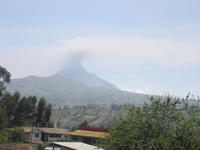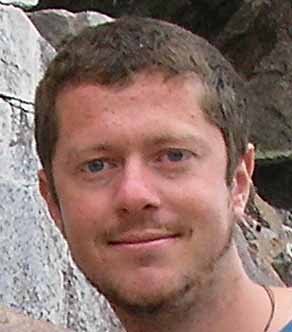Arriving overland from Ecuador, surf town Huanchaco would be one of my first stops. The native surfers here, in fact doubled as fisherman. They go out on their reed boats called “totora’s”, surfing back with their catch as they have been for over 2500 years.
The nearby Chan Chan ruins form what was once pre-Colombia’s largest city in the Americas and the largest mud-brick city in the world. (I didn’t know that when I was there, as I was too tight to pay the 1 dollar for a guide; I’m just reading it up now, in the pretense of appearing factual to you all). Peru is just full of hidden gems and surprises.
 Chan-Chan
Chan-Chan
There can be no greater contrast in human conditions, than the northern slums of Lima, and upmarket Miraflores. On one side, the shacks built of clay are literally perched on the edges of cliffs (step into your garden and you fall a few hundred feet into the river and to your death); Miraflores is seaming with 5 star hotels and boulevards lined with boutiques.
In all fairness, Peru’s capital is not a place where tourists hang around. A quick visit to the old town main square and I was readying for the next adventure. Plaza de las Armas emerged to be my favourite square of the continent yet.
 Lima main square
Lima main square
On a German motor way, Lima to Cuzco would take 2 hours. Here in the high Peruvian Andes, where roads are treacherous and buses plunging off mountains, where young drivers badly calculate bends or fall asleep behind the wheel are common place tales; the journey takes 24 hours.
On a mission of doing the whole continent by land and river, (ie no flights), and with Gina meeting me in Cuzco in a couple days, there was only time to do either: the Nazca Lines; or the Condor Canyon. I went for the "ALIEN SPECTACLE".

Boarding the Nazca Cessna
I may well be the least grateful person on Earth. I fully enjoyed the 40 minute flight in my four-seater Cessna over the Nazca Lines; seeing the monkey, the spider, the hummingbird etc. But I remain sceptic as too its true marvel. It’s definitely not alien, and I wouldn’t be surprised if even a relatively modern human conception. Maria Reiche (long time researcher of the lines) would kill me for saying that.


The Astronaut (Above - The Spider)
Flying at 7000 feet, you can still thoroughly enjoy the gigantic figures: 130m condor wingspan, The Hummingbird
The Hummingbird
90m monkey tail and my favourite, the astronaut in the mountain. The best bit, all at a measly cost of 30 dollars. Possibly the cheapest major tourist attraction in the world. Let’s see what happens over the next five years. If the lines and figures aren’t enough, the landscape is awe-inspiring. One guy I later met, said he was so dazzled by the scenery he forgot about the lines. Hmm?  The spectacular landscape
The spectacular landscape
Always a risk, eating fish in the town’s cheapest restaurant. No more so, than before a 17 hour non-stop bus journey with a broken toilet. I’ll let you imagine the rest.

Inca street
3 kilos lighter, I descend upon the archeological capital of the Americas. Cuzco. I thought this was just a stopping point before heading to the nearby “real” reason everybody comes here. But Cuzco has the charm and historical beauty to rival anywhere I’d been. It wasn’t without it’s own ruins either. On the hill above the city lay Sacsayhuaman, scene of one of the bitterest battles between the Spanish and the Manco Inca. At least I think that’s what the guide was saying. He was talking in Quechuan, the local ancient language.
 Incans
Incans
The Incas are famous for fitting stones together with no other joining agent than the stones themselves. That is to say, that the stones are piled atop each other in such painstaking precision, that they hold firm together as if by cement or other form of glue. It is even said, that you can’t fit a needle through the joins. (Or am I confusing the biblical needle through the camel or something). Well they’re solid and a tourist attraction in any case.

13 sides
If it has more than 4 sides, this supposedly makes it more impressive, as it would have taken that much longer to size them up with their partnering stones. One even had 13 sides, though I'm sure it's actually 14.
The train to Aguas Calientes from Cuzco is a rip-off. The alternative: a horseback tour through 3 major ruins, a bus ride through the majestic Sacred Valley; a visit to yet another spectacular ruin - Ollantaytambo; and a separate train that would also take us to the town that is indigenous to tourism.

Sacred valley
The splendour that is Aguas Calientes, could only be fully realised in the morning as we’d arrived late at night. Nestled between towering mountains, we were about to embark on what many people see as the only reason to come to Peru, further more, South America

Macho Me
We were a 20 minute bus ride from MACHU PICHU. Originally we’d planned to do the 1 hour climb up to the ruins, but adverse weather saw the justification of an extortionate bus ride. The weather continued to dampen our spirit, even when witnessing one of man’s greatest earthly achievements. Eventually the sun came out and we enjoyed the afternoon exploring a lost civilization. More I cannot say about this place, other than it is no cliche; it is every centimeter as amazing as it’s souped up to be.

Me, Machu and a Llama
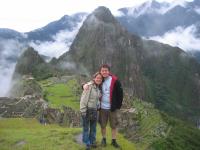
Me, Machu and a Gina
About a year ago, I’d asked someone to translate the title of the Simon and Garfunkel song: El Condor Pase. They answered: “The condor flies”.
“Yeah”, I replied, “But what is a condor”.
Now I was on my way to the Colca Canyon more importantly: The valley of the Condors. I was on my way to finding out exaclty what the word meant.
The second you get of the bus which drops you off at the "Mirador del Condor", you are descended upon by a pack of wolves. Ticket agents, claiming I had to pay for the right to stand on this part of the mountain. A farce, surely. I refused to pay, so they chased me round for half an hour, I almost made one cry and there were countless police threats before we came to a compromise. I would pay the national fee, as if I was a Peruvian and is always a million times cheaper. The way I saw it, I got a really cool ticket to keep in my book of momentoes.
Mach Pichu
Most people arrive at this lookout around 10 or 11 am in the bus loads. A guide had once stated the best times for a viewing are early in the mornig, or late in the afternoon. I chose to arrive before the hoards and was there in almost solitude for the first 3 hours.
The tourists came in their mini-vans, of course I arrived by chicken bus, and nonone put up a fight with these ticket guys. I guess thats why they get away with it. The majority are suckers.
Most of these guided hopefuls, were only afforded 1 maybe 2 hours by their bored and impatient drivers, for a chance of spotting a Condor.
None came. They all left, maybe 200 people, and then there was just me and a handful of other budget travellers waiting for the last local bus out at 1pm. It was almost time and still no sighting. For a moment a large bird flew above our heads, but the thrill came to a sudden halt when a local guide yawned that it was merely a large eagle.
As the bus was winding its way towards us around the mountain, I made a crazy decision. I was in the middle of this colca canyon (the worlds deepest at 3800m), a three hour walk in any direction from civilization. There was no food or water in sight, and a factor that later hit me, no shade from the sun. But I came all the way back from Bolivia, specifically, to see a bloody Condor. I would have to starve it out and wait for the late afternoon (the next best chance for a sighting). At 1pm I was the only human in any 10km direction.
I managed to maintain my sanity by inventing games with stones. The heat was sweltering, and I was feeble from thirst and hunger and sunburn. But there was a higher purpose. I was going to see a Condor.
Only in Peru
No I wasn't. After 10 hours of waiting I saw a car approaching and rushed to the main road and luckily got a lift back to Cabanaconde. At least I was spared an exhaustive hike.
The next morning I would pass this Mirador again on my way back to Bolivia, so I could allow myself a final two hour slot for another chance.
No luck. I slumped back onto the bus depleted and resigned. I couldnt get the number 12 out of my head, as that was the ridiculous amount of hours I'd just wasted in my life. Oh, I did get to see a Hummingbird. Ironic. I'm there to see one of the world's biggest and God affords me the smallest.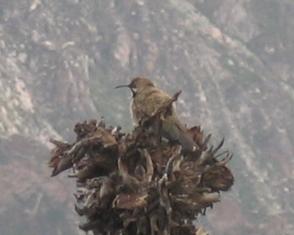 Worlds Smallest - Amidst the Biggest: Hummingbird
Worlds Smallest - Amidst the Biggest: Hummingbird
Whilst leaving the Canyon I look back out the bus window and mutter something about no longer believing in the creature.
I'm just dozing away, when two french people I'd met and shared my ordeal with are shouting: "Jerry, Jerry, look out the left window."
There were two Condors circling the bus

 CONDOR (YIPHEEEEE)
CONDOR (YIPHEEEEE)

